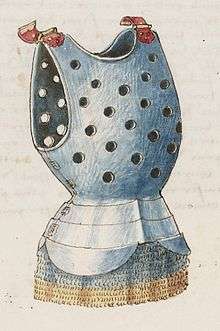Codpiece

A codpiece (from Middle English: cod, meaning "scrotum") is a covering flap or pouch that attaches to the front of the crotch of men's trousers and usually accentuates the genital area. It was held closed by string ties, buttons, or other methods. It was an important item of European clothing in the 15th and 16th centuries, and is still worn in the modern era in performance costumes, for rock music and metal musicians, and in the leather subculture, while an athletic cup protects in a similar fashion.
History

From the ancient world there are extant depictions of the codpiece; for example, archaeological recovery at Minoan Knossos on Crete has yielded figurines, some of which wear a codpiece.[1] Most of what is objectively known about the cut, fit, and materials of Renaissance clothing is learned from realistic portraits, clothing inventories, descriptive receipts for payments of artifacts, or tailors' cutting guides.[2] In the 14th century, men's hose were two separate legs worn over linen drawers, leaving a man's genitals covered only by a layer of linen. As the century wore on and men's hemlines rose, the hose became longer and joined at the centre back but remained open at the centre front. The shortening of the cote or doublet resulted in under-disguised genitals, so the codpiece began life as a triangular piece of fabric covering the gap.
As time passed, codpieces became shaped and padded to emphasize rather than to conceal, reaching their peak of size and decoration in the 1540s before falling out of use by the 1590s. Scholars have noted that the appearance of Renaissance codpiece was coincident with aggressive spread of syphilis in the early 16th century, and suggest that it may have first served to allow extra room in the clothing for bandages or other dressings for the afflicted male genitals.[3][4]
Armor of the 16th century followed civilian fashion, and for a time armored codpieces were a prominent addition to the best full harnesses. A few of these are on display in museums today: the Metropolitan Museum of Art in New York City has one, as did the Higgins Armory[5] in Worcester, Massachusetts until its close; the armor of Henry VIII in the Tower of London has a codpiece.[6] In later periods, the codpiece became an object of the derision showered on outlandish fashions. Renaissance humorist François Rabelais jokingly refers to a book titled On the Dignity of Codpieces in the foreword to his book The Histories of Gargantua and Pantagruel.[7]
Through the same linguistic route, cods became a modern slang term for the male genitalia.
In contemporary culture
Subcultural attire
Resembling codpieces, jock straps made of leather can be worn in leather subcultural attire to cover and confine the genitals of a man, sometimes while wearing leather chaps. Rather than accentuating the male genitalia through exaggeration of the size of the wearer's endowment, attention can be drawn through decorative adornment such as metallic studs.
Heavy metal fashion

The codpiece crossed over from the leather subculture to become an established part of heavy metal fashion performance costume when Rob Halford, of the band Judas Priest, began wearing clothing adopted from the gay biker and leather subculture while promoting the Killing Machine (AKA Hell Bent for Leather) album in 1978.[8] Heavy metal singer King Diamond has been known to wear a codpiece as part of his performance outfits. Metal singer Till Lindemann of Rammstein occasionally wears codpieces on stage.
Black metal musician and Satanist Infernus wore a codpiece as part of his attire during the Ad Majorem Sathanas Gloriam era of Gorgoroth. William Murderface from the cartoon series Metalocalypse also wears a codpiece on several occasions. GWAR frontman Oderus Urungus wore a codpiece called The Cuttlefish of Cthulhu.
Pop music
Cameo front man Larry Blackmon sports a codpiece in his videos "Word Up" and "Candy", which became his trademark. Guns N' Roses front man Axl Rose wore a codpiece for most of the Appetite for Destruction Tour. Ian Anderson, Jethro Tull's front man, also is known for his codpiece from the mid-1970s.
See also
References
Notes
- ↑ C. Michael Hogan. 2007. Knossos fieldnotes, Modern Antiquarian Archived April 9, 2016, at the Wayback Machine..
- ↑ Grace Q. Vicary, Cultural Anthropology, Vol. 4, No. 1 (Feb., 1989), Visual Art as Social Data: The Renaissance Codpiece, pp. 3-25.
- ↑ Vicary, Grace Q. (February 1989). "Visual Art as Social Data: The Renaissance Codpiece". Cultural Anthropology. 4 (1): 3–25. doi:10.1525/can.1989.4.1.02a00010.
- ↑ Reed, CS (December 2004). "The codpiece: social fashion or medical need?" (PDF). Internal medicine journal. 34 (12): 684–6. doi:10.1111/j.1445-5994.2004.00635.x. PMID 15610213. Archived from the original (PDF) on 2016-04-10. Retrieved 10 April 2016.
- ↑ John Grabenstein, "Archived copy". Archived from the original on 2016-10-12. Retrieved 2005-09-17..
- ↑ Paddock, David Edge & John Miles (1995). Arms & armor of the medieval knight : an illustrated history of weaponry in the Middle Ages (Reprinted. ed.). New York: Crescent Books. ISBN 0517103192.
- ↑ "Worlds of the Renaissance 2000 - Dina McArdle Project". Albertrabil.com. Archived from the original on 2004-01-21. Retrieved 2012-01-19.
- ↑
Further reading
- Ashelford, Jane: The Art of Dress: Clothing and Society 1500–1914, Abrams, 1996. ISBN 0-8109-6317-5.
- Ashelford, Jane. The Visual History of Costume: The Sixteenth Century. 1983 edition (ISBN 0-89676-076-6), 1994 reprint (ISBN 0-7134-6828-9).
- Edge, David: Arms and Armor of Medieval Knights: An Illustrated History of Weaponry in the Middle Ages.
- Hearn, Karen, ed. Dynasties: Painting in Tudor and Jacobean England 1530–1630. New York: Rizzoli, 1995. ISBN 0-8478-1940-X.
- Bodemer, Brett: "Pantagruel's Seventh Chapter:The Title as Suspect Codpiece."
External links
 Media related to Codpieces at Wikimedia Commons
Media related to Codpieces at Wikimedia Commons
